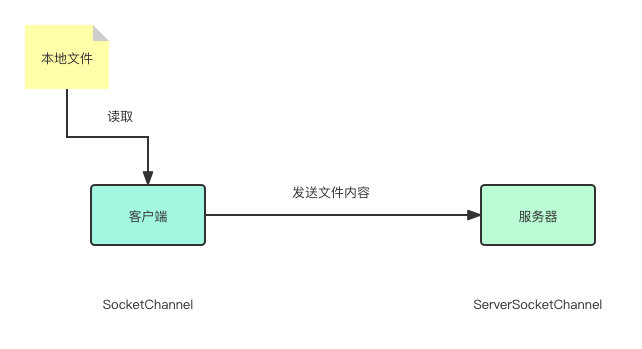这里提一嘴,调用完 write 并不是立即就写入磁盘,也可以在操作系统的缓存里。如果需要立即刷盘,则调用 channel.force(true); 即可。
RandomAccessFile怎么用的呢?其实跟之前两个差不多:
public static void main(String[] args) throws IOException {// 指定需要生成的文件名称
String targetFileName = "target-file.txt";
// 创建 RandomAccessFile, 赋予可读(r)、可写(w)的权限
RandomAccessFile accessFile = new RandomAccessFile(targetFileName, "rw");
FileChannel fileChannel = accessFile.getChannel();
// 创建 ByteBuffer 并写入数据
ByteBuffer buffer = ByteBuffer.allocate(16);
buffer.put("shDEQuanZhanBiJi".getBytes(StandardCharsets.UTF_8));
// 切换到 buffer 的读模式
buffer.flip();
// 调用 write 将 buffer 的数据写入到 channel, channel 再写数据到磁盘文件
fileChannel.write(buffer);
// 相当于清空 buffer
buffer.clear();
// 将之前写入到 channel 的数据再读入到 buffer
fileChannel.read(buffer);
// 打印 buffer 中的内容
printBuffer(buffer);
fileChannel.close();
}
运行之后的效果就是,会生成一个名为 target-file.txt 的文件,内容就是 shDEQuanZhanBiJi。并且控制台会将之前写入 channel 的 shDEQuanZhanBiJi 打印出来。
老规矩,细节都在注释中。值得注意的是 new RandomAccessFile(targetFileName, "rw"); 里的 rw 。注释里也写了,代表赋予可读、可写的权限。
再值得注意的是,你不能说把 rw 改成 w。

不能这么玩,因为它就是一个单纯的字符串匹配,可供选择的就这么些:

可以看到,r 必不可少...:
r 只能读
rw 既能读,也能写
rws 和 rwd 功能和 rw 大致是相同的,可读、可写。唯一区别是他们会将每次改动强制刷到磁盘,并且 rws 会将操作系统对该文件的元数据也一起刷盘,体现就是文件的更新时间会更新,而 rwd 不会将文件的元数据刷盘
两个 SocketChannel由于这俩一个负责连接传输,另一个负责连接的监听,所以就放在一起来讲了。这一小节我们大概要做这件事:

但是为了能让大家直接运行起来,客户端这侧就不从磁盘文件读取了,直接用 ByteBuffer。大家可以运行起来之后,自己尝试从磁盘上去加载。还是先看代码,首先是服务器的:
ServerSocketChannel public static void main(String[] args) throws IOException {// 打开一个 ServerSocketChannel
ServerSocketChannel serverSocketChannel = ServerSocketChannel.open();
// 绑定 8080 端口
serverSocketChannel.bind(new InetSocketAddress(8080));
// 开始接受客户端连接
SocketChannel socketChannel = serverSocketChannel.accept();
// 获取连接成功
System.out.printf("socketChannel %s connected\n", socketChannel);
// 准备 ByteBuffer 以从 socketChannel 中读取数据
ByteBuffer buffer = ByteBuffer.allocate(16);
// 开始读取数据
System.out.println("before read");
int read = socketChannel.read(buffer);
System.out.printf("read complete, read bytes length: %s \n", read);
printBuffer(buffer);
}
这里我们使用的是 Java NIO 中默认的阻塞模式,仅仅作为一个掩饰,如果想要 ServerSocketChannel 进入非阻塞模式,可在 open 之后,调用:
serverSocketChannel.configureBlocking(false);由于我们这里是阻塞模式,所以在代码运行到 serverSocketChannel.accept(); 时,会陷入阻塞状态,直到有客户端过来建立连接。同理,read 方法也是阻塞的,如果客户端一直没有写入数据,那么服务器就会一直阻塞在 read 。
SocketChannel直接先给代码:
public static void main(String[] args) throws IOException {// 打开一个 SocketChannel
SocketChannel socketChannel = SocketChannel.open();
// 连接到 localhost 的 8080 端口
socketChannel.connect(new InetSocketAddress("localhost", 8080));
// 准备 ByteBuffer
ByteBuffer buffer = ByteBuffer.allocate(16);
buffer.put(Charset.defaultCharset().encode("test"));
// 将 buffer 切换成读模式 & 向 channel 中写入数据
buffer.flip();
socketChannel.write(buffer);
}
先启动服务器,再启动客户端。可以看到服务器侧的控制台有如下的输出:
socketChannel java.nio.channels.SocketChannel[connected local=http://www.likecs.com/127.0.0.1:8080 remote=http://www.likecs.com/127.0.0.1:64373] connectedbefore read
read complete, read bytes length: 4
BUFFER VALUE: test
Datagram
这个就比较简单,首先是客户端的代码:
public static void main(String[] args) throws IOException {DatagramChannel datagramChannel = DatagramChannel.open();
// 构建 buffer 数据
ByteBuffer buffer = ByteBuffer.allocate(16);
buffer.put(Charset.defaultCharset().encode("test"));
// 切换到 buffer 的读模式
buffer.flip();
datagramChannel.send(buffer, new InetSocketAddress("localhost", 8080));
}
然后是服务器:
public static void main(String[] args) throws IOException {DatagramChannel datagramChannel = DatagramChannel.open();
datagramChannel.bind(new InetSocketAddress(8080));
ByteBuffer buffer = ByteBuffer.allocate(16);
datagramChannel.receive(buffer);
printBuffer(buffer);
}

